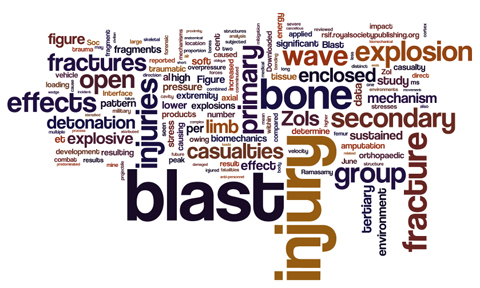Scrambled Science
How much can you learn from the words that make up a scientific paper? When they are in order and presented in the traditional scientific way, a great deal. However, even when they are taken out of context, you can still learn a lot about the research.
In this post we have taken a recent research paper published by the Blast research group at Imperial College, London, and created a word cloud where the size of each word varies, depending on how often it’s used.
The paper, “Blast-related fracture patterns: a forensic biomechanical approach” by A Ramasamy et al was published in the Journal of the Royal Society Interface, and looks at the different effects of combat explosions on the body, comparing blasts that occur inside vehicles to those that take place in the open.
A quick look through this word cloud reveals the main thrust of the research. However, on closer examination you can start to uncover the nature of science itself. Words such as “data” and “figure” indicate how researchers validate their conclusions. The prevalence of the word, “et” (from a citation “et al”), indicates that the group has used a number of references to both justify their findings and give them greater meaning by linking them to a wider scientific network.
On the other hand, it also raises some questions. What are ZoIs? And what do waves have to do with blast injuries? These technical details and nuances of the research process are something that can only be understood if you delve deeper in the lab’s research.
Citation:
Arul Ramasamy, Adam M. Hill, Spyros Masouros, Iain Gibb, Anthony M. J. Bull, and Jon C. Clasper
Blast-related fracture patterns: a forensic biomechanical approach
J R Soc Interface 2010 : rsif.2010.0476v1-rsif20100476.


[…] If you want to know what it’s about, check out our latest Inside Knowledge short post. […]